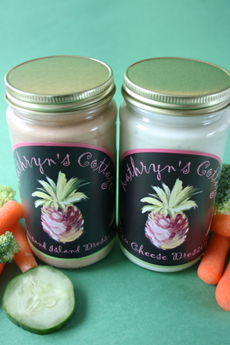PRODUCT: Kathryn’s Cottage Salad Dressings

Best of class: These salad dressings are truly pure perfection. Photo by Hannah Kaminsky |THE NIBBLE. |
We hardly ever buy prepared salad dressings. Dressing is quick and easy to make, and our homemade dressings taste better than what we could buy.
Except for Kathryn’s Cottage. Proprietor Nancy Little Hucks makes perfect Bleu Cheese and Thousand Island Dressings—even better than ours. We’re in love with them. Kathryn’s mother was a blue cheese dressing fanatic (like us) and tried it everywhere she went (like us). Never finding one that was ideal, she experimented over the years to perfect her own recipe. It contains mayonnaise, cream cheese, cottage cheeese, blue cheese, buttermilk, onions, lemon juice, vinegar and spices, including a touch of dill. It might take us years to crack the recipe; in the interim, we’ll keep buying Kathryn’s. Why are Kathryn’s Cottage dressings perfect? The Bleu Cheese Dressing has just the right body—not thick, as so many blue cheese dressings are. It has just the right amount of cheese—not too little, as with many dressings, nor too much so to be overly cheesy. It is made with the finest ingredients and no preservatives. It tastes like the best recipe was just whipped up in your kitchen.
|
|
| The dressing was served from 1968-1995 in Ms. Hucks’ parents’ restaurants, The Little Kitchen in Mooresville, N.C. and Little’s in Myrtle Beach, S.C. A 12-ounce jar is $9.95 (but given the amount of quality blue cheese inside, it’s worth it). Tell your specialty grocer to order some; or you can buy them directly from KathrynsCottageKitchen.com. We don’t mean to give the Thousand Island Dressing short shrift. Made of mayonnaise, chili sauce, ketchup, relish, spices and Worcestershire sauce, it is also a perfect rendition of a popular recipe. On salads, in dips and sauces, both dressings rock! The dressings are made fresh with the finest ingredients and no preservatives. They are shipped chilled in an insulated container and must be refrigerated. You should consume it in a couple of weeks; but you’ll have zero problem with that, we promise! CULINARY QUESTION: Why do some people write “blue cheese” and others, “bleu cheese?” “Bleu” is the French word for blue; the French word for cheese is “fromage.” So “bleu cheese” is an incorrectly-conceived term: half French, half English. However, the French do not refer to blue cheese as “fromage blue.” Instead, they call it persille or fromage à pâte persille. “Persille” is the French word for parsley, so why is blue cheese called “parsley” or “parsley paste cheese?” Because long ago, the blue veins in blue cheese reminded someone of parsley leaves! Paste refers to the interior of the cheese—what’s inside the rind. More food trivia: The pineapple on the label of Kathryn’s Cottage dressing is a sign of hospitality. That’s because until the era of modern shipping, pineapples were so costly in Europe that to serve one to guests was the sign of a very generous host. HERE’S MORE ABOUT BLUE CHEESE LEARN MORE ABOUT CHEESE IN OUR DELICIOUS CHEESE GLOSSARY
|
||


